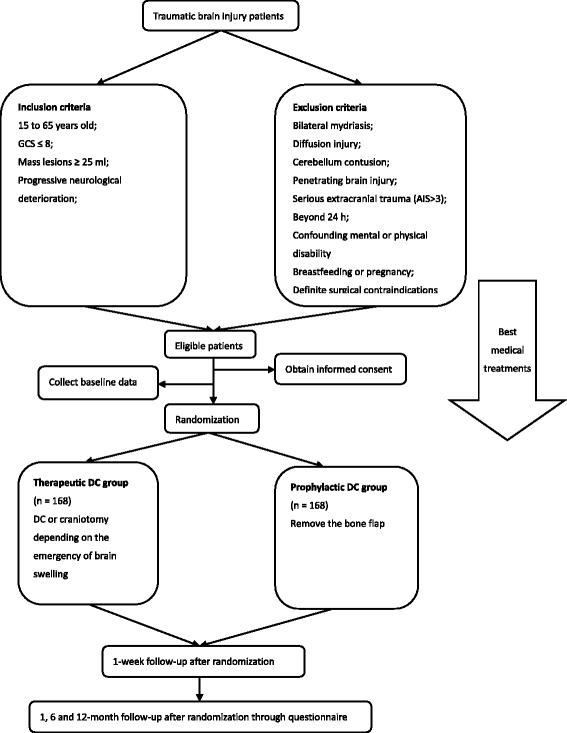Prospective randomized evaluation of therapeutic decompressive craniectomy in severe traumatic brain injury with mass lesions (PRECIS): study protocol for a controlled trial
- PMID: 26727957
- PMCID: PMC4700654
- DOI: 10.1186/s12883-015-0524-9
Prospective randomized evaluation of therapeutic decompressive craniectomy in severe traumatic brain injury with mass lesions (PRECIS): study protocol for a controlled trial
Abstract
Background: For cases of severe traumatic brain injury, during primary operation, neurosurgeons usually face a dilemma of whether or not to remove the bone flap after mass lesion evacuation. Decompressive craniectomy, which involves expansion of fixed cranial cavity, is used to treat intra-operative brain swelling and post-operative malignant intracranial hypertension. However, due to indefinite indication, the decision to perform this procedure heavily relies on personal experiences. In addition, decompressive craniectomy is associated with various complications, and the procedure lacks strong evidence of better outcomes. In the present study, we designed a prospective, randomized, controlled trial to clarify the effect of decompressive craniectomy in severe traumatic brain injury patients with mass lesions.
Methods: PRECIS is a prospective, randomized, assessor-blind, single center clinical trial. In this trial, 336 patients with traumatic mass lesions will be randomly allocated to a therapeutic decompressive craniectomy group or a prophylactic decompressive craniectomy group. In the therapeutic decompressive craniectomy group, the bone flap will be removed or replaced depending on the emergence of brain swelling. In the prophylactic decompressive craniectomy group, the bone flap will be removed after mass lesion evacuation. A stepwise management of intracranial pressure will be provided according to the Brain Trauma Foundation guidelines. Salvage decompressive craniectomy will be performed for craniotomy patients once there is evidence of imaging deterioration and post-operative malignant intracranial hypertension. Participants will be assessed at 1, 6 and 12 months after randomization. The primary endpoint is favorable outcome according to the Extended Glasgow Outcome Score (5-8) at 12 months. The secondary endpoints include quality of life measured by EQ-5D, mortality, complications, intracranial pressure and cerebral perfusion pressure control and incidence of salvage craniectomy in craniotomy patients at each investigation time point.
Discussion: This study will provide evidence to optimize primary decompressive craniectomy application and assess outcomes and risks for mass lesions in severe traumatic brain injury.
Trial registration: ISRCTN20139421.
References
-
- Yuji O, David S, Gloria GT. International Lessons for Road Safety in the People’s Republic of China. Asian Development Bank 2013, http://www.adb.org/sites/default/files/publication/30338/kps-road-safety.... Accessed 28 Feb 2015
-
- Compagnone C, Murray GD, Teasdale GM, Maas AI, Esposito D, Princi P, et al. The management of patients with intradural posttraumatic mass lesions: A multicenter survey of current approaches to surgical management in 729 patients coordinated by the European Brain Injury Consortium. Neurosurgery. 2005;57:1183–92. doi: 10.1227/01.NEU.0000186239.10915.09. - DOI - PubMed
-
- Bullock MR, Chesnut R, Ghajar J, Gordon D, Hartl R, Newell DW, et al. Surgical management of traumatic parenchymal lesions. Neurosurgery. 2006;58:S25–46. - PubMed
Publication types
MeSH terms
Associated data
LinkOut - more resources
Full Text Sources
Other Literature Sources


